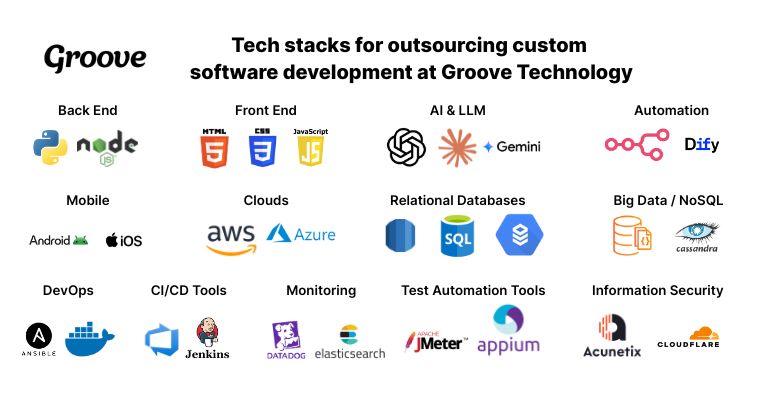Outsourcing custom software development enables businesses to hire external experts to create, maintain, and enhance software tailored to their specific needs, saving them time and resources while gaining access to specialized skills. This approach enables clients to focus on their core operations while ensuring high-quality software delivery that aligns with their goals.
This article highlights what outsourced custom software development involves, explains the benefits you can gain from it, and provides practical guidance on how to choose the right partner. By reading, you will understand how outsourcing can improve efficiency, reduce costs, and help you achieve successful software projects without overloading your internal teams.

1. What is outsourcing custom software development?
Outsourcing custom software development involves hiring an external team to design, develop, and maintain software solutions uniquely tailored to a company’s specific workflows, goals, and challenges, rather than relying on generic, off-the-shelf products. Unlike traditional outsourcing, which often focuses on delivering standardized or pre-defined software services, custom software outsourcing emphasizes personalization, flexibility, and strategic alignment with the client’s business model.
This approach not only provides access to specialized expertise in niche technologies but also enables companies to build solutions that integrate seamlessly with existing systems, enhance competitive advantage, and evolve as business needs change, all while saving time, optimizing costs, and keeping internal teams focused on core operations.

2. What are the benefits of outsourcing custom software development?
Outsourced custom software development offers six key advantages that highlight the core software development outsourcing benefits, from cost efficiency to strategic growth. It provides tailored solutions that align with your business processes, ensures cost-effectiveness tied to value, and gives access to expert global talent. Businesses also benefit from faster time-to-market, full ownership with a competitive edge, and reliable long-term support that reduces obsolescence risks, helping your organization stay efficient, innovative, and future-ready.
Tailored solutions for your business needs
Custom software adapts directly to how your business operates, allowing you to choose only the features you need. This reflects one of the key outsourcing software development benefits, helping you avoid unnecessary complexity and extra costs while streamlining workflows and automating repetitive tasks to help your team work faster. Efficiency improves as human errors decrease, and your software can grow with your company, keeping up with evolving demands and supporting long-term success.
Cost-effectiveness tied to value
Custom software provides long-term value that often outweighs the initial investment, eliminating recurring licensing fees while reducing workflow redundancies and inefficiencies. Every feature aligns directly with your business processes, ensuring that the resources you invest deliver measurable benefits and support sustainable growth over time.

Access to expert talent
By partnering with a specialized outsourcing provider, businesses can tap into global talent pools and niche skills that may be difficult or expensive to maintain in-house. These teams often have deep experience with the latest frameworks, cloud infrastructure, AI integration, or cybersecurity standards, enabling your project to leverage cutting-edge technology from the start.
Faster time-to-market
Outsourcing custom software development enables external teams to begin working on your project immediately, and it provides the flexibility to scale resources as needed, which helps keep timelines on track and avoid delays. This approach enables your business to respond more quickly to new market opportunities or operational demands, and it accelerates delivery compared to building an internal team from scratch.
Ownership and competitive advantage
Ownership of custom software gives your business full control over the code, strengthening your intellectual property while opening possibilities to monetize or license your solution later. Unique software creates differentiation in the market, allowing you to offer specialized tools or portals that competitors do not have, which helps you maintain a competitive edge and effectively expand your business opportunities.
Reliable support and reduced obsolescence risk
Support from a development partner gives your business faster and more accurate solutions, and it reduces downtime because the team already understands your environment and workflows. Iterative updates enable you to add new features, enhance security, and align with industry trends. This approach minimizes the risk of your software becoming outdated, while keeping your systems relevant and competitive as your business evolves.

3. How to get started with outsourced custom software development?
Outsourcing custom software development involves a clear five-step outsourcing software development process that guides your project from defining project requirements, selecting the right development partner, executing development in structured iterations, setting communication protocols to testing and refining the solution, which you can explore in detail in the following sections.
Step 1: Define your project requirements and scope
Defining your project requirements and scope sets the foundation for a successful outsourcing process, guiding both your internal team and the external vendor to stay aligned and focused on clear objectives. A precise description of the problem to solve and the opportunity to leverage it allows you to communicate effectively with your development partner.
Adding both functional and non-functional requirements creates a roadmap that reduces misunderstandings. Realistic timelines, budget constraints, and phased milestones help track progress and manage expectations while keeping the project on schedule and within budget.
To make this step actionable, ask yourself:
- What main problem should this software solve?
- What goals do you want to achieve in the short term and long term?
- Who are the primary users or audiences of the software?
- Which features and functionalities are essential for your project?
- How will you determine whether the project is successful?
Step 2: Evaluate and select your development partner
Selecting the right outsourced custom software development partner requires careful research and thorough evaluation. This process helps you identify a team that can reliably deliver on your project goals while aligning with both your technical and business needs.
To begin, vendor websites, client testimonials, and professional recommendations offer valuable first impressions. From there, assessing the vendor’s experience in your industry and familiarity with your technology stack will indicate whether they can manage projects of similar complexity.
Finally, verifying certifications and years of experience strengthens confidence in their credibility. For extra assurance, conducting small test assignments allows you to evaluate their real capabilities before committing to a long-term partnership.
To guide your selection, ask yourself:
- What skills and expertise does the vendor bring to the table?
- Have they handled projects of a similar scope and industry to mine?
- Can they share case studies, references, or testimonials from past clients?
- Does their pricing model fit within my budget and project requirements?
Step 3: Execute development in structured iterations
The development stage is where your software vision starts to take shape. It begins with thorough preparation, laying a strong foundation for smooth progress, followed by release planning that defines visual wireframes or mock-ups as a clear roadmap for the team.
Next comes the design phase, which focuses on crafting an intuitive user interface and seamless user experience. After that, coding takes place in short cycles of one to two weeks, each targeting specific features. Throughout these cycles, continuous refinement and feedback loops ensure that every component stays aligned with your goals.
Finally, effective communication and structured iterations connect all stages together. They enable both your team and the vendor to closely track progress, make timely adjustments, and maintain strong project momentum from start to finish.
To guide your development phase, consider asking:
- How often should we review sprint outputs to stay aligned with our goals?
- Who on our team is responsible for approving wireframes, UI/UX designs, and feature releases?
- Which performance indicators will confirm that each feature addresses the intended problem?
- Do we have in-house capacity to test features during the sprint, or should the vendor provide QA support?

Step 4: Build communication protocols and workflows
Transparent communication forms the backbone of every successful outsourced software project. To achieve this, it’s essential to set clear communication protocols that align your team with the vendor and minimize misunderstandings.
In this process, expectations for roles, responsibilities, workflows, and quality standards should be clearly defined and consistently reinforced. Along with that, using the right collaboration tools enhances visibility, making it easier to track progress and share updates in real time.
Finally, regular meetings maintain alignment. They create space to review progress, address challenges, and plan next steps. When the project is divided into milestones, it adds clarity, keeps everyone accountable, and ensures the timely delivery of a high-quality product.
To shape effective communication protocols, think about:
- What is the level of overlap between our time zones, and how many hours can stakeholders dedicate to real-time discussions?
- Who will act as the main point of contact for design approvals, scope changes, and technical decisions?
- What response times should we expect for urgent issues versus feature clarifications?
- How will we document and track meeting decisions to prevent miscommunications in the future?
Step 5: Test, measure, and refine your solution
Testing, measuring, and refining the software completes the development cycle, and creating a transparent process helps catch bugs early while gathering user feedback to align with expectations. Clear protocols for testing, tracking key metrics, and documenting issues enable us to refine the product continuously. Utilizing automation tools can streamline repetitive tasks while improving accuracy. Post-launch support and scalable architecture provide further assurance that the solution can grow alongside your needs.
To guide this step, ask yourself:
- Are the project goals and scheduled deliverables being achieved on time?
- Which metrics or performance indicators are most effective in tracking progress?
- Are there any obstacles slowing down the workflow or development?
- Has every phase undergone thorough testing and validation before moving forward?

4. Outsourcing custom software development vs. In-house software development
When comparing software development approaches, businesses often choose between outsourcing and in-house development. Each option offers distinct advantages and trade-offs:
- Outsourcing custom software development: This approach allows companies to delegate coding, design, and delivery tasks to an external team while still maintaining control over project goals and business requirements. It provides access to specialized expertise, flexible staffing, and faster timelines, especially valuable for short-term or resource-intensive projects.
- In-house software development: In contrast, this model involves building your software with an internal team of employees who work directly under your management. These developers integrate deeply into your company culture, understand your operations, and give you full control over technology choices, coding standards, and project progress. However, it also demands continuous investment in salaries, benefits, and ongoing training.
The table below compares key factors between these two approaches to help you decide which model suits your business needs:
| Factor | Outsourcing Development | In-house Development |
| Cost structure | Pay per project or contract term, lower salary expenses, no benefits, or 401(k) contributions. | High fixed costs, including salaries, healthcare, 401(k) plans, and PTO, and continuous expenses regardless of workload. |
| Timeline | Start immediately with pre-staffed teams, parallel workflows, and multiple developers working simultaneously. | Hiring delays project start, smaller teams work sequentially, and building the team takes weeks or months. |
| Commitment duration | Short-term engagement ends with project delivery, easy to scale up or down. | Long-term employment makes it difficult to reduce staff during low-demand periods, as the team remains on payroll. |
| Skill availability | Access to broad technology expertise, specialists across frameworks and languages, and a flexible focus per project. | Limited to hired employees, small teams may specialize in a few technologies; expanding requires new hires. |
| Business focus | The vendor handles technical tasks, allowing you to focus on sales, marketing, and core operations. | You oversee technology decisions, coding standards, and progress, requiring more management attention. |
| Quality control | Quality depends on vendor selection; offshore teams may need rework. | Direct oversight ensures adherence to standards and practical application, complete control over deliverables. |
| Team knowledge | A limited understanding of your business model and culture means that knowledge transfer ends with project completion. | Deep integration with company operations, ongoing exposure to business challenges, team suggests improvements. |
| Communication | Time zone differences complicate coordination, and travel adds costs for onshore vendors. | The same location and business hours enable immediate collaboration and face-to-face meetings without additional logistics. |
| Security & IP protection | Foreign laws may provide weaker intellectual property protection, and legal agreements required. | Local laws protect software and IP, employment contracts secure ownership, and lower the risk of code misuse. |
| Cultural alignment | Different work cultures can impact communication and expectations, potentially leading to misalignment that delays projects. | Shared culture and values, better alignment on quality standards, and communication norms. |
| Staffing flexibility | Easy to adjust team size based on project demands, scale without hiring or firing. | Staffing peaks and valleys can lead to inefficiencies; adjusting quickly is challenging. |
5. Why can outsourcing custom software development projects fail?
Custom software projects can fail for six common reasons, and understanding these pitfalls helps you plan more effectively and avoid costly mistakes:
- Undefined purpose: Project goals lose clarity when teams pursue endless nice-to-have features without understanding the value they provide, and development drifts because the team cannot answer what problem is being solved or how success is measured.
- Too many features at the start: Many projects fail because businesses try to build everything at once. Adding too many features or solving too many problems from the beginning makes the project complicated, slows progress, and increases costs. In the end, some features may never even be used. Starting smaller with an MVP (Minimum Viable Product) helps save money, test ideas early, and find the right direction before expanding.
- Communication breakdowns: Misunderstandings emerge when requirements are incomplete or updates on new features are delayed, and teams without proper channels struggle to align timelines, deliverables, and testable outputs consistently.
- Budget miscalculations: Projects often face problems when the budget is underestimated or lacks flexibility. Unexpected costs such as extra development time or new feature requests can easily exceed the original plan. To prevent this, it is important to review financial estimates regularly and adjust the budget as the project progresses to keep spending aligned with actual needs.
- Substandard development methods: Development firms that skip best practices, avoid agile processes, or remain unresponsive to support hinder project success, and neglecting thorough testing or business context can lead to subpar outcomes despite possessing technical skills.
- Choosing the wrong outsourcing partner: Selecting a vendor based solely on cost, rather than capability and compatibility, often leads to performance issues later on. A partner without proven experience in your industry or technology stack may struggle to deliver quality results. Evaluating technical skills, project management practices, and cultural fit upfront is critical to long-term success.

6. So, how to reduce risks in custom software development outsourcing?
Reducing risks in custom software development requires careful planning, structured processes, and ongoing collaboration, and there are seven effective strategies that help safeguard your project while keeping it aligned with business goals:
- Start with a Minimum Viable Product (MVP): MVP development focuses on the smallest version of your software that fulfills core stakeholder needs, clearly separating must-have features from optional ones. This approach allows you to gain approvals early and test value before investing heavily.
- Adopt agile development: Agile practices rely on short cycles to build, test, and adjust features incrementally, and combining sprints with an MVP approach lets your team adapt quickly while maintaining focus on essential outcomes.
- Address technical risks early: Early evaluation of new frameworks, tools, and integrations helps identify weaknesses, compatibility issues, and scalability limits, and tackling these challenges upfront prevents expensive delays and ensures a robust foundation.
- Communicate frequently: Clear, frequent communication with your vendor sets expectations for meetings, reporting, and escalations, and helps surface issues promptly so that scope, timeline, and budget changes can be addressed before they escalate.
- Engage users throughout development: Continuous user involvement provides feedback on workflows and usability, and validating designs at key milestones ensures that the software remains intuitive, functional, and aligned with daily operational needs.
- Test thoroughly and often: Regular testing at each stage validates performance, usability, and integration, and detecting issues early reduces rework while maintaining the software's reliability as features grow in complexity.
- Plan for ongoing support: Maintenance, updates, and feature enhancements protect your investment after launch, and keeping documentation current allows your team to implement future changes smoothly while adapting to evolving business needs.

7. Why should you choose Groove Technology for outsourcing custom software development?
At Groove Technology, outsourced custom software development focuses on delivering seamless collaboration, clear cost visibility, and highly skilled engineering teams, helping you complete projects efficiently, on schedule, and with reliable quality. Our approach combines technical expertise with practical processes to ensure a smooth and predictable development experience.
- Easy onboarding: Our process design ensures smooth integration with your existing workflows and frameworks, while our engineers actively clarify questions to align expectations with outcomes.
- Transparent cost management: Our financial structure provides upfront clarity with detailed breakdowns and flexible adjustments, enabling you to control budgets and scale teams efficiently.
- Quality assurance: The recruitment strategy selects certified developers with strong technical skills and proactive mindsets, while ongoing training sustains high performance and ensures reliable delivery.
- Comprehensive outsourcing services: We provide flexible outsourcing for various types of projects, including web applications, mobile apps, eCommerce platforms, enterprise software, and cloud-based systems. This versatility allows businesses to find all their technology solutions within one trusted partner.

Tech stacks for outsourcing custom software development at Groove Technology
At Groove Technology, custom software development outsourcing utilizes a diverse array of tech stacks to support projects across various platforms and business needs, providing flexibility, reliability, and efficiency while maintaining high performance and delivering future-ready solutions:
| Category | Tech Stacks |
| Back End | .NET, Python, Node.js |
| Front End | HTML5, CSS3, JavaScript (JS), Angular, React.js, Meteor, Vue.js, Ember.js |
| AI & LLM | OpenAI, Claude, Gemini, Grok, Deepseek, LangChain, TensorFlow |
| Automation | n8n, Dify, Azure AI Studio, Power Automate |
| Mobile | Android, Flutter, iOS, PWA (Progressive Web App), React Native, Xamarin |
| Clouds | AWS, Azure, Digital Ocean, Google Developer Tools, Rackspace |
| Relational Databases | Amazon RDS, Azure SQL Database, Google Cloud SQL, MySQL, Oracle, PostgreSQL, SQL Server |
| Big Data / NoSQL | Amazon DocumentDB, Amazon DynamoDB, Apache Cassandra, Amazon Redshift, Apache Hive, Apache Kafka, Apache Spark, Apache Zookeeper, AWS Elasticache, Azure Blob Storage, Azure Cosmos DB, Azure Data Lake, Google Cloud Datastore, Hadoop, HBase, MongoDB |
| DevOps | Ansible, Chef, Docker, Kubernetes, Mesos, OpenShift, Packer, Puppet, SaltStack, Terraform |
| CI/CD Tools | AWS Developer Tools, Azure DevOps, Jenkins, TeamCity, TravisCI, Google Developer Tools, GitHub |
| Monitoring | Datadog, Elasticsearch, Grafana, Nagios, Prometheus, Zabbix |
| Test Automation Tools | Apache JMeter, Appium, Coded UI Test, fMBT, HP QuickTest Professional, Postman, Protractor, Ranorex, Selenium, TestComplete, TestStack White, UFT One, XCTest |
| Information Security | Acunetix, Burp Suite, CloudFlare, Masscan, Metasploit, Nessus, Nmap, Radar, Siege |

This article has explored the key challenges in custom software projects and outlined practical ways to reduce risks while delivering successful outcomes. We covered why projects fail, how Minimum Viable Products, Agile development, early technical risk management, ongoing communication, user involvement, frequent testing, and planned support help you achieve your goals
We also introduced Groove Technology’s outsourcing custom software development approach and how we bring efficiency, transparency, and skilled engineering to every stage of your project. By following these strategies, you can feel confident that your software investments generate real value and maintain long-term reliability.




